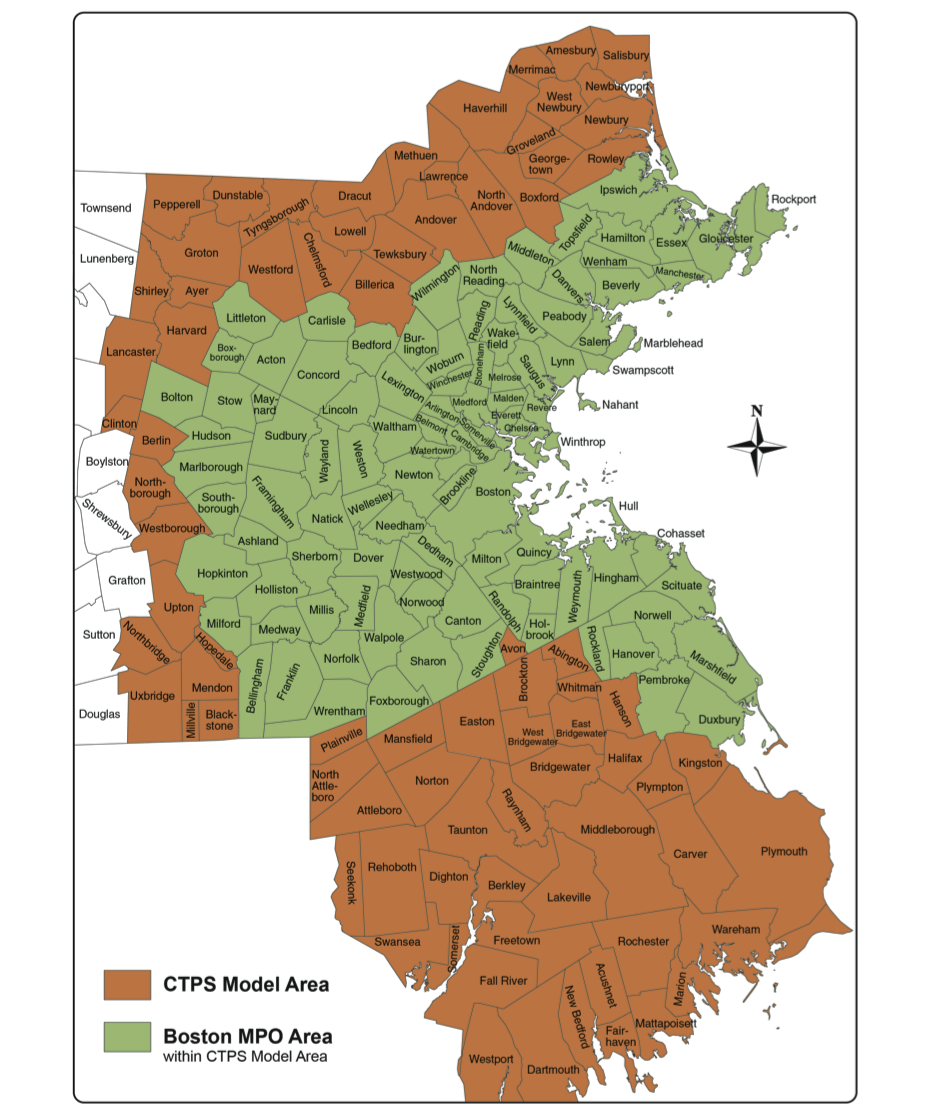
Chapter 3 — Transportation Needs in the Boston Region
A critical early step in developing the LRTP was to gather, organize, and analyze available sources of data about the existing transportation system. This process resulted in the MPO’s Needs Assessment, an interactive online database of transportation, population, and employment conditions. MPO staff used the Needs Assessment application to analyze various components of the transportation system, their capacity, serviceability, and current and projected use. The Needs Assessment also includes a report that summarizes the region’s future transportation requirements based on staff’s analysis.
Not only did the Needs Assessment analysis guide the MPO when deciding how to address the region’s needs through the LRTP, it also will guide future decision making about which projects to fund in the TIP, and which studies to conduct through the UPWP. The Needs Assessment also establishes a baseline for the MPO’s performance-measurement process, which will track progress over time to determine whether planned changes to the transportation system are moving the MPO toward its goals and objectives.
This chapter presents a summary of the region’s needs (described in full in a separate Needs Assessment document). Both the Needs Assessment document and the interactive Needs Assessment application may be accessed through the MPO’s website at http://www.ctps.org/Drupal/charting_2040_needs.
Information in this chapter—and the online Needs Assessment document—has been organized according to the LRTP’s goals (Chapter 1), which staff used to evaluate projects for scenario planning and project selection for the recommended LRTP (Chapter 5), and are related to the topics of:
The online Needs Assessment document includes the following chapters, which contain details about the needs, as well as the conditions that create the needs:
For transportation planning purposes, the MPO maintains a travel demand model, which includes the 101 municipalities in the MPO region plus an additional 63 municipalities adjacent to the MPO area (see Figure 3.1). While the Needs Assessment addresses only the needs of the municipalities in the MPO, it does take into consideration conditions and travel activity in other parts of the larger region that affect the MPO.
FIGURE 3.1
Model Areas

The Needs Assessment incorporates information from previous and ongoing transportation planning work—including the Paths to a Sustainable Region LRTP, the MBTA’s Program for Mass Transportation, the MPO’s Congestion Management Process (CMP), transportation equity outreach, MPO studies, and special studies—for data inputs.
Staff also used the MPO’s travel demand model and draft demographic projections in the Needs Assessment, as existing and projected socioeconomic information (population, housing, and employment data) and the existing and proposed transportation network were important factors in determining transportation needs. In the modeling process, the adopted LRTP used a base year of 2012 and a future year of 2040 for the transportation network and socioeconomic data.
The following sections offer an overview of transportation system’s needs for the next twenty-five years. Detailed information about each goal may be found in Chapter 4 of the Needs Assessment, which also includes:
Overall, safety in the region’s transportation system has been improving. However, at the same time certain types of crashes and resultant injuries have increased. Reducing the number of transportation-related accidents, injuries, and fatalities—as well as related property damage, pain, and suffering—is the MPO’s highest priority.
Despite the overall reduction in the number of crashes, fatalities, and injuries between 2006 and 2012, the number of crashes and injuries involving pedestrians and bicyclists rose: pedestrian crashes increased by 18 percent, and injuries grew by 31 percent; bicycle crashes increased by 36 percent, and injuries jumped by 46 percent. Roughly two-thirds of pedestrian and bicycle crashes resulted in an injury.
Staff identified safety needs by analyzing data for high crash locations, intersections, and lane departures, as well as accidents involving pedestrians, bicyclists, and trucks. Tables 3.1–3.3 display summary information about the region’s safety needs.
TABLE 3.1
Safety Needs in the Boston Region MPO
| Emphasis Area |
Problem |
Description of Needs |
|---|---|---|
High Crash Locations |
The number of all crashes should be reduced. Pedestrian and bicycle crashes and injuries are rising; 46% of these result in injury. |
Top 25 Crash Locations (see Table 3.2 for a list of locations)
Facilities to improve safety for bicycles and pedestrians are needed. |
Intersections |
More than one in five fatalities occurs at an intersection. |
Seventy-nine of the state’s Top-200 Crash Locations are in the Boston Region.
Roadway corridors with multiple Top-200 Crash Locations are:
|
Lane Departures |
Lane departure crashes cause 55% of roadway fatalities and 24% of incapacitating injuries.
Interstates make up 5% of lane miles, yet account for 15% of lane departure crashes.
Arterials account for less than 25% of lane miles but more than 50% of lane departure crashes. |
Roadways with significant numbers of lane departure crashes include:
|
Pedestrians |
One of the state’s nine strategic areas and an ongoing focus of the Boston Region MPO.
In the Boston region, pedestrians comprise a growing share of crashes and a disproportionately high share of injuries. |
MassDOT Highway Safety Improvement Program (HSIP) Crash Cluster locations: Downtown areas of: Boston, Chelsea, Framingham, Lynn, Malden, Natick, Peabody, Salem, Waltham, and Wellesley Corridors in:
Suburban Areas: many arterials and local roadways where sidewalk coverage is inadequate |
Bicyclists |
In the Boston region, bicyclists comprise a growing share of crashes and a disproportionately high share of injuries. |
MassDOT HSIP Bicycle Cluster locations: Downtown areas of: Beverly, Chelsea, Framingham, Lexington, Lynn, Natick, and Salem Corridors in:
Regionwide: bicycle infrastructure is limited; bike paths and other infrastructure are needed in all areas of the region. |
Trucks |
One of the state’s four proactive emphasis areas; trucks account for a greater proportion of crash severity than other modes—approximately five percent of crashes and nine percent of fatalities between 2006 and 2012 |
MPO Compiled High Crash locations are at older interchanges with obsolete designs:
|
Source: Central Transportation Planning Staff.
TABLE 3.2
Top-25 Highway Crash Locations in the Boston Region MPO
| Municipalities |
EPDO |
Top 200 |
HSIP Crash Cluster |
Truck Crash Cluster |
Pedestrian Crash Cluster |
Bicycle Crash Cluster |
|
|---|---|---|---|---|---|---|---|
Interstate 93 at Columbia Rd |
Boston |
464 |
X |
X |
X |
X |
|
Middlesex Turnpike at Interstate 95 |
Burlington |
388 |
X |
X |
|||
Route 3 at Route 18 (Main Street) |
Weymouth |
339 |
X |
X |
|||
Interstate 93 (Near Ramps for Furnace Brook Parkway) |
Quincy |
330 |
X |
X |
|||
East St Rotary at Rte 1 and Rte 128 |
Westwood |
328 |
X |
X |
|||
Interstate 95 at Interstate 93 |
Reading |
326 |
X |
X |
X |
||
I-93 at Granite Ave (Exit 11) |
Milton |
325 |
X |
X |
|||
Interstate 95 at Route 2 |
Lexington |
324 |
X |
X |
|||
Route 9 at Interstate 95 |
Wellesley |
320 |
X |
X |
|||
I-93 at North Washington St |
Boston |
319 |
X |
X |
|||
I-93 at Rte 138 (Washington St) |
Canton |
316 |
X |
X |
|||
I-93 at Route 3A (Gallivan Blvd/Neponset Ave) |
Boston |
271 |
X |
X |
|||
Interstate 95 at Rte 4 (Bedford St) |
Lexington |
270 |
X |
X |
|||
Route 18 (Main Street) at West St |
Weymouth |
247 |
X |
X |
X |
||
Interstate 93 at Rte 37 (Granite St) |
Braintree |
245 |
X |
X |
X |
||
Route 139 (Lindelof Ave) at Rte 24 |
Stoughton |
240 |
X |
||||
Interstate 93 at Leverett Connector |
Boston |
236 |
X |
||||
Interstate 93 at Route 28 |
Medford |
233 |
X |
X |
X |
||
Rte 128 at Route 114 (Andover St) |
Peabody |
219 |
X |
X |
|||
I-93 at Rte 28 and Mystic Ave |
Somerville |
214 |
X |
X |
X |
||
Storrow Dr at David G. Mugar Way |
Boston |
212 |
X |
||||
Rte 28 (Randolph Ave) at Chickatawbut Rd |
Milton |
203 |
X |
X |
|||
Route 2 – Crosby’s Corner |
Concord/Lincoln |
200 |
X |
X |
|||
Route 1 at Route 129 |
Lynnfield |
194 |
X |
X |
|||
Route 1 at Route 129 (Walnut St) |
Saugus |
193 |
X |
EPDO = Equivalent Property Damage Only. HSIP = Highway Safety Improvement Program.
Source: MassDOT Registry of Motor Vehicles.
TABLE 3.3
Locations with Multiple Safety Needs
| Municipalities |
Top 200 |
HSIP Crash Cluster |
Truck Crash Cluster |
Pedestrian Crash Cluster |
Bicycle Crash Cluster |
|
|---|---|---|---|---|---|---|
Downtown Framingham |
Framingham |
X |
X |
X |
X |
X |
Route 20 (Main Street) and Moody St |
Waltham |
X |
X |
X |
X |
X |
Watertown Square |
Watertown |
X |
X |
X |
X |
X |
Washington Street |
Salem |
X |
X |
X |
X |
X |
Everett Avenue |
Chelsea |
X |
X |
X |
X |
X |
Essex Street |
Lynn |
X |
X |
|
X |
X |
Route 107 (Western Avenue) |
Lynn |
X |
X |
X |
X |
|
Massachusetts Avenue |
Arlington |
X |
X |
X |
X |
|
Route 16 (Alewife Brook Parkway) |
Arlington, Somerville, Cambridge |
X |
X |
X |
|
X |
Broadway |
Chelsea |
|
X |
X |
X |
X |
Newtonville |
Newton |
|
X |
X |
X |
X |
Route 16 (East Main Street) |
Milford |
X |
X |
X |
|
|
I-495 at Route 126 (Hartford Ave) |
Bellingham |
X |
X |
X |
|
|
Downtown Quincy |
Quincy |
X |
X |
|
X |
|
I-95 at Route 16 (Washington St) |
Newton |
X |
X |
X |
|
|
Route 16 (Revere Beach Parkway) |
Revere, Everett, Medford |
X |
X |
X |
|
|
I-495 at Route 1A (South Street) |
Wrentham |
X |
X |
X |
|
|
Route 20 (East Main Street) |
Marlborough |
X |
X |
X |
|
|
Route 9 |
Framingham, Natick |
X |
X |
X |
|
|
Downtown Natick |
Natick |
|
X |
|
X |
X |
Downtown Lynn |
Lynn |
|
X |
|
X |
X |
Route 1A |
Lynn |
|
X |
X |
X |
|
Rte 28 (McGrath Hwy) at Washington St |
Somerville |
|
X |
|
X |
X |
Newton Center |
Newton |
|
X |
|
X |
X |
Cambridge Street |
Cambridge |
|
X |
|
X |
X |
Route 16 (Mystic Valley Parkway) |
Medford |
|
X |
X |
X |
|
HSIP = Highway Safety Improvement Program.
Source: MassDOT Registry of Motor Vehicles.
Demands on roadway and transit facilities have stressed them to the point that routine maintenance is insufficient to keep up with necessary repairs. The result is a significant backlog of maintenance and SGR projects on all parts of the transportation system, including bridges, roadway pavement, transit rolling stock, and traffic and transit control equipment. The region’s transportation infrastructure is aging and heavily used. In addition, parts of the transportation system may be compromised if climate-change trends continue as projected.
The system needs to be brought into an SGR, maintained at that level, and enhanced to ensure personal mobility, efficient movement of goods, and protection from potential sea-level rising and storm-induced flooding. The region’s financial constraints require the MPO to set priorities, considering the most crucial maintenance needs and the most effective ways to deploy funding. At the same time, the MPO must improve the resiliency of infrastructure that could be affected by climate change.
The MPO's uses its TIP evaluation criteria to determine whether a project improves substandard pavement, signal operations, intermodal accommodations and connections to transit; it implements intelligent operations system strategies to assess and prioritize the system’s preservation and maintenance needs for projects it considers for funding (see Table 3.4).
TABLE 3.4
System Preservation Needs in the Boston MPO Region
| Emphasis Area |
Problem |
Description of Needs |
|---|---|---|
Bridges |
Of the 2,866 bridges in the region:
Bridge Health Index:
|
Meet the MassDOT performance measure to prevent the number of structurally deficient bridges from exceeding 463 statewide
Meet the MassDOT performance measure to maintain a systemwide bridge health index of at least 81.98 |
Pavement Management |
MassDOT-maintained roadways:
|
MassDOT-maintained arterial roadways make up 62% of monitored roadways, however 90% of the arterial roadways are in poor condition; larger expanses of arterials in poor condition are located in: Boston, Cambridge, Chelsea, Everett, Lynn, Malden, Medford, Newton, Revere, and Somerville
|
Transit Infrastructure and Rolling Stock |
Transit system needs to be brought into SGR
Maintaining existing capital assets must be the highest priority |
SGR and Maintenance Needs:
|
Freight Network |
Many express highways are built to outdated design standards for trucks
|
Needs include:
|
Climate Change Adaptation |
Some transportation infrastructure, including tunnels, is in hazard areas and locations that are vulnerable to inundation, among other hazards. |
The Central Artery and other infrastructure may need retrofitting or other adaptations to protect them from the impacts of hazards and climate change |
Source: Central Transportation Planning Staff.
Reducing congestion and managing the capacity of all transportation infrastructure and services is essential to increase mobility, decrease vehicle emissions, promote healthy travel options, and ease disruption and economic losses caused by travel delay.
Although increasing capacity has long been a strategy to reduce congestion, its effects have not proved long lasting. The MPO now is adopting capacity and mobility strategies that enhance the system through O&M type projects, such as improving access and connectivity to transit services, closing gaps and reducing bottlenecks for all modes, completing the bicycle and pedestrian networks, and providing for first- and last-mile connections.
The MPO identified capacity and mobility needs by analyzing the reliability and capacity of roadway and transit infrastructure and services, and the connectivity of transit, pedestrian, and bicycle infrastructure (see Table 3.5).
TABLE 3.5
Capacity Management and Mobility Needs in the Boston Region MPO
| Emphasis Area |
Problem |
Description of Needs |
|---|---|---|
Roadway Reliability Needs |
The Needs Assessment identified a priority set of expressway and arterial congested locations using speed- and travel-time indices, volume-to-capacity ratios, and crashes as factors. Addressing these locations will also address truck freight concerns. |
Priority congested locations – Expressways:
Priority congested locations – Arterial Corridors 24 locations (see Figure 3.2):
|
Transit Reliability Needs |
Maintain the MBTA performance measures for transit reliability
|
Needs include service standards adherence:
|
Transit Capacity Needs |
A number of major infrastructure constraints on the MBTA system limit capacity and hinder expansion
Future demand for transit will increase needs for transit investments |
Infrastructure constraints include:
Future Needs Include:
|
Transit Connectivity |
Congested transit- or bicycle-parking facility
General Access Needs
|
|
Bicycle and Pedestrian Network Connectivity |
Eleven top priority bicycle gaps to be addressed
Baystate Greenway (BSG) Priority 100 corridor projects in the Boston Region
General Bicycle and Pedestrian Improvements
Only 52 percent of the region’s non-limited-access roadways have a sidewalk on at least one side of the street.
Inadequate snow removal reduces mobility
|
Top priority bicycle gaps are shown in Figure 3.5
BSG 100 priority corridor projects are shown in Figure 3.5
Bike trails to Boston from the northeast, north, and southeast
Sidewalks on at least one side of all streets
|
Source: Central Transportation Planning Staff.
FIGURE 3.2
Bottleneck Locations
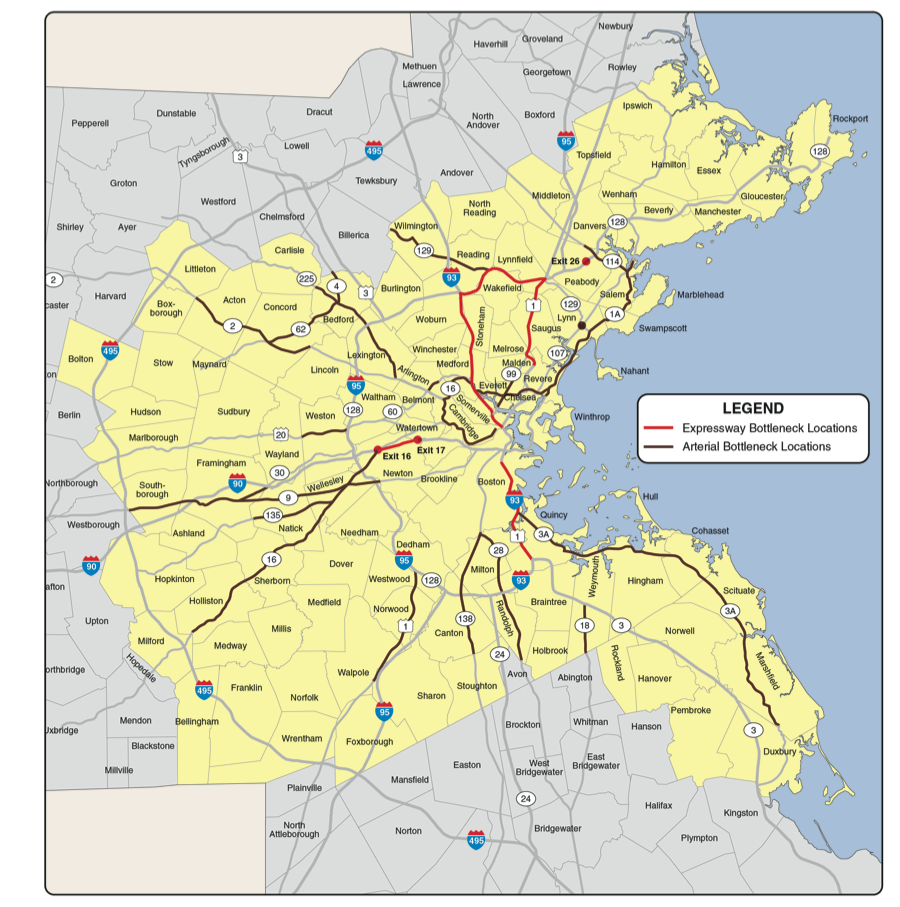
FIGURE 3.3
Park-and-Ride Locations with a Utilization Rate of More than 85%
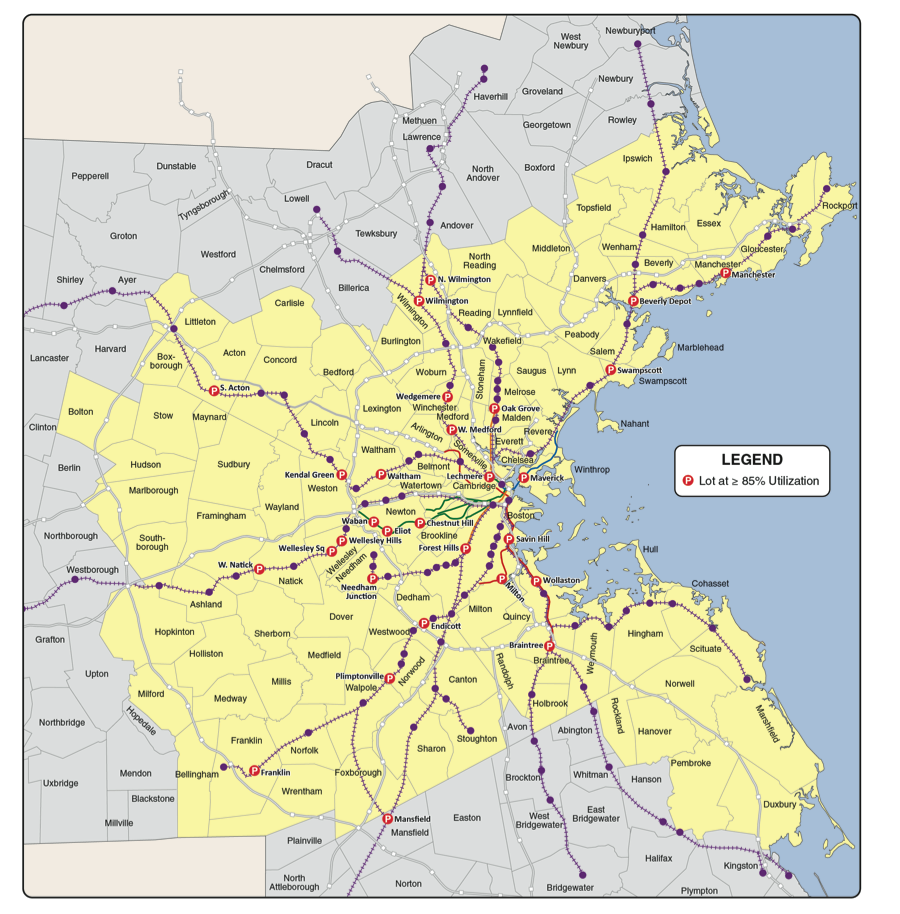
FIGURE 3.4
Bicycle Parking Facilities with a Utilization Rate of More than 85%

FIGURE 3.5
Priority Bicycle Gaps and Baystate Greenway Locations
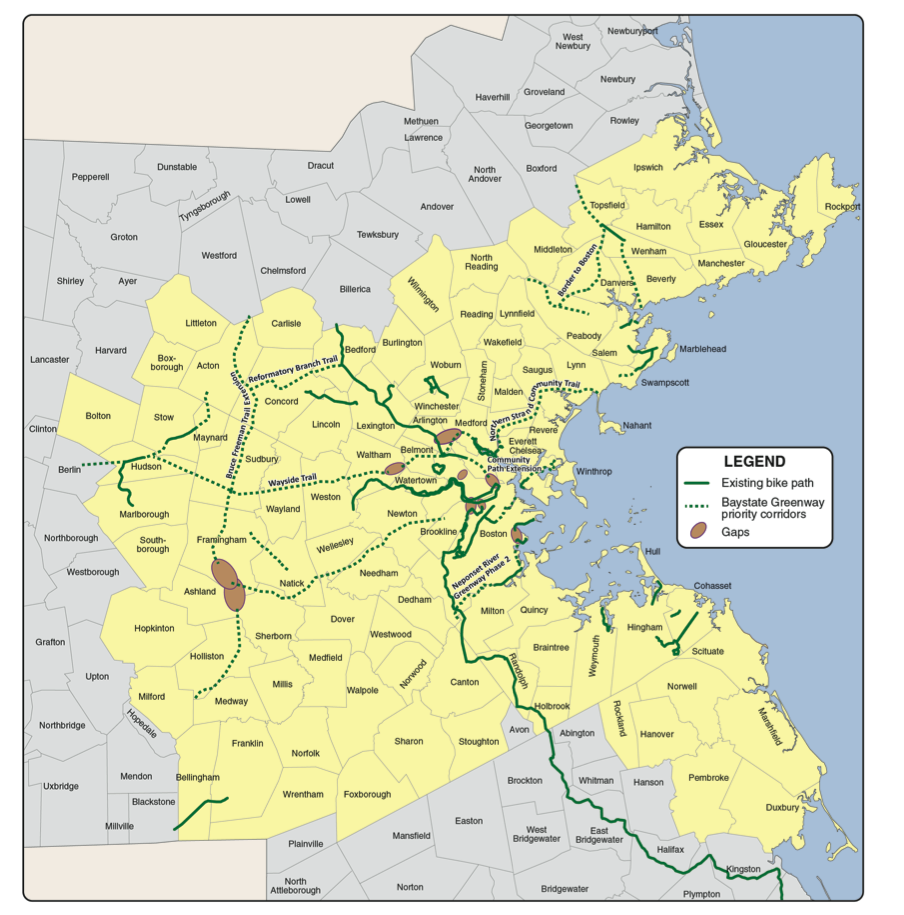
The MPO has made significant progress toward improving air quality in the region, which is now in attainment for ozone and particulate matter and remains in maintenance for carbon monoxide.1 Continued vigilance is needed to keep emissions of these pollutants at acceptable levels.
The largest environmental threat the MPO now faces is the need to reduce greenhouse gas emissions that contribute to climate change, which if unchecked, could impair our transportation system and way of life. In addition, transportation can negatively affect environmental resources and land use patterns if they induce sprawl or development in or near priority preservation areas areas (see Economic Vitality section and Figure 3.8).
To comply with federal and state requirements, as well as MPO policy, the MPO tracks air quality by continuously monitoring estimated or projected levels of pollutants, including volatile organic compounds (VOC), nitrogen oxides (NOx), carbon monoxide (CO), particulate matter (PM), and carbon dioxide (CO2). In the LRTP and TIP project-selection processes, the MPO reviews and rates individual projects on how well they meet criteria established to protect the environment.
Addressing some of the needs identified under the Capacity Management and Mobility goal also will help the MPO achieve the Clean Air and Clean Communities goal, as programs that reduce vehicle-miles traveled (VMT) contribute to lower emissions of VOC, NOx, CO, CO2, and PM.
TABLE 3.6
Clean Air and Clean Communities Needs in the Boston Region MPO
Problem |
Description of Needs |
|---|---|
The MPO must continue monitoring levels of carbon monoxide (CO) and carbon dioxide (CO2) and should continue monitoring the pollutants volatile organic compounds (VOC), nitrogen oxides (NOx), and particulate matter (PM) |
Identify projects and programs that can meet criteria established to protect the environment
Reducing vehicle-miles of travel (VMT) will help reduce emissions of VOC, NOx, CO, CO2, and PM. |
Source: Central Transportation Planning Staff.
Historically, some minority and economically disadvantaged areas have endured the negative effects of the transportation system disproportionally—for example, via placement of infrastructure from which they do not benefit; poor access to, or maintenance of, necessary services; and by not being included in the transportation-planning process. In addition, youth, the elderly, and people with disabilities of various kinds face special challenges when using the transportation system. Although progress has been made to remedy these problems, much remains to be done to identify affected populations and ensure equal treatment and access to transportation services, mobility, and decision making.
The MPO determines the transportation needs of people in transportation equity (TE) areas—those with higher concentrations of minority and/or low-income residents (see Figures 3.6 and 3.7 and Chapter 7)—in a number of ways. Staff post a TE needs survey on the MPO’s website; the MPO conducts forums and meetings to solicit input; staff attend various meetings where needs and transportation gaps are discussed; and staff keep current on reports and studies that identify these needs, which generally fall into several categories, including:
The MPO addresses regional transportation equity through TIP evaluation criteria, where projects that address a transportation issue in an TE neighborhood can score points. MPO staff give positive ratings to projects that could benefit TE areas, and negative ratings to projects that might burden these areas. This scoring system gives projects that address transportation equity issues an advantage, as the MPO considers these ratings when deciding which projects should be funded in the LRTP or TIP.
TABLE 3.7
Transportation Equity Needs in the Boston Region MPO
Problem |
Description of Needs |
|
|---|---|---|
Lack of adequate transit service to environmental-justice communities
Some transportation needs are addressed system wide and some are location specific |
Identified needs:
|
|
Source: Central Transportation Planning Staff.
FIGURE 3.6
Transportation Equity Areas in the Boston Region MPO Regionwide

FIGURE 3.7
Transportation Equity Areas in the Boston Region MPO Central Area
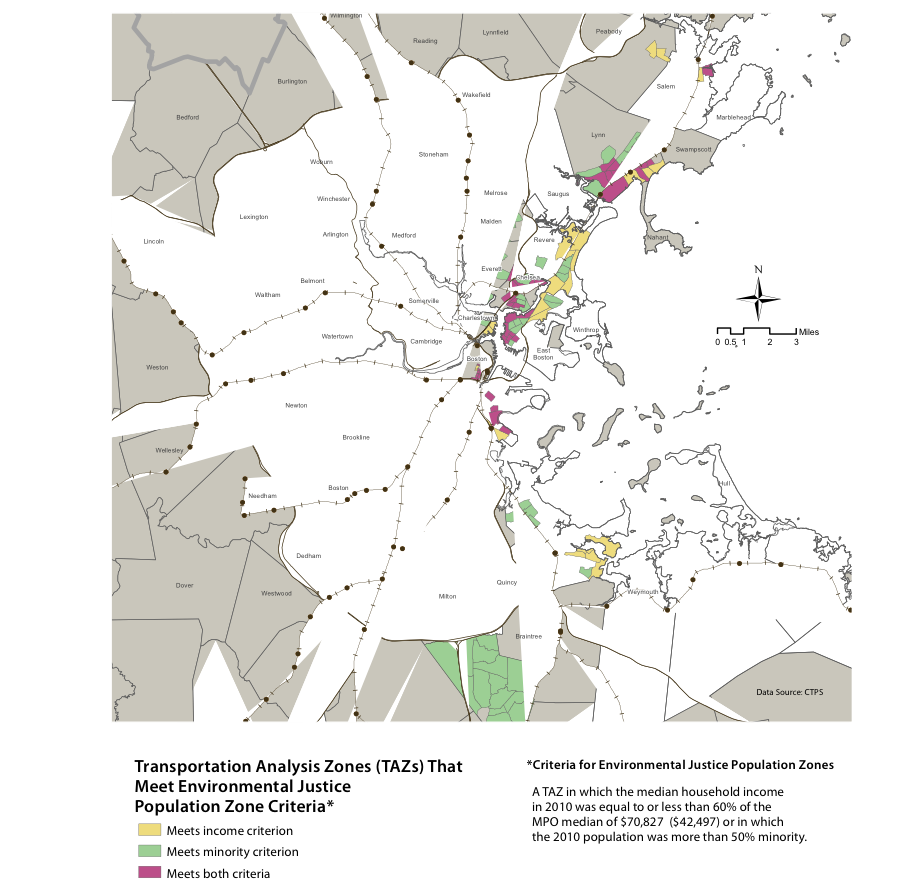
Land use, demographics, the economy, the environment, and the transportation system are closely interrelated, and changes to any one factor can affect the others negatively. The MPO can support economic development by focusing attention on the transportation infrastructure needs of MAPC-identified priority development and preservation areas in the region (Figure 3.8) as it prioritizes its limited regional funding.
The Massachusetts Executive Office of Housing and Economic Development (EOHED), the Massachusetts Executive Office of Energy and Environmental Affairs (EOEEA), and MAPC collaborated on a process to identify local, regional, and state-level priority development and preservation areas in municipalities within the MPO area. These areas can support additional housing, employment growth, creation and preservation of open space, and the type of continued economic vitality and future growth that the market demands, and which communities desire. The MPO has worked with MAPC and state agencies to understand the infrastructure needs of these areas and to identify transportation projects that could address them.
TABLE 3.8
Economic Vitality Needs in the Boston Region MPO
Problem |
Description of Needs |
|---|---|
The region’s economic vitality depends on a high-performing, multi-modal transportation system |
Infrastructure improvements are needed to support growth in the priority development areas |
Source: Central Transportation Planning Staff.
FIGURE 3.8
Regionally Significant Priority Development and Preservation Areas
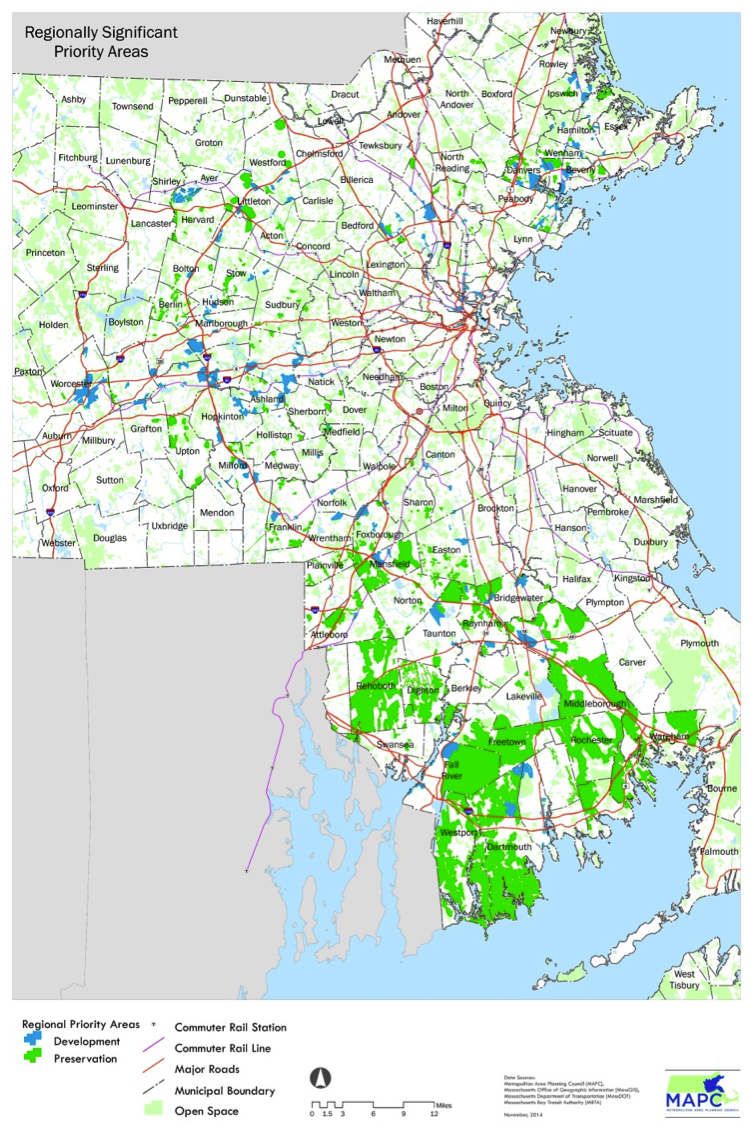
Clearly, the Boston region has extensive transportation maintenance and modernization requirements, and must continue to address safety and mobility for all modes. In fact, all of the MPO’s goal areas contain certain inadequacies that the MPO should confront in its multimodal approach to meeting the region’s needs through 2040. However, MPO staff estimate that attending to these needs likely would exceed anticipated financial resources between now and 2040. Therefore, the MPO will face difficult decisions as it prioritizes when and how to allocate resources to guide transportation investment decisions throughout this LRTP’s time span.
1 A maintenance area is one that has been reclassified as being in attainment, but on which the MPO is still required to report.